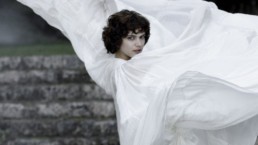‘The Dancer’ Review: Soko Gives Blood, Sweat, and Tears in Moving Biopic
A look into the life of the "Goddess of Light."
The name Loïe Fuller may not be a familiar one today, but it is one that we will likely come to know.
Born in 1862, Fuller stands as a pioneer of both modern dance and theatrical lighting techniques, as well as a champion for feminism and gay rights. For as much as she accomplished, however, Fuller had remained relatively unknown… until now. Much like the revolutionary woman she portrays on-screen, the multi-hyphenate French artist/actress/singer Soko takes on the role of Loïe Fuller in director Stéphanie Di Giusto’s historical biopic, The Dancer (La Danseuse).
Regarded now as the “Goddess of Light,” Loïe (Soko) was predisposed to be an artist. Born and raised in the American Midwest in the 19th Century, she struggled to find her calling until, after much trial and error in other areas of the arts, she created a new type of revolutionary dance movement, called “The Serpentine.”
Holding onto long bamboo sticks and draped in white silk, Loïe would swing her arms and contort her body to make the most amazing butterfly-like shapes, made even more powerful with the use of strategic lighting which would project multiple colors onto her dress. This new movement fascinated audiences, and admiration for this graceful wonder grew. However, when the young apprentice Isadora Duncan (Lily-Rose Depp) gets involved in Loïe’s professional and personal life, Isadora quickly supersedes everything Loïe has worked her entire life for.
Soko is mesmerizing as Loïe, and not just because of how beautifully her sharp features play against the gracefulness of her movements.
Soko is mesmerizing as Loïe, and not just because of how beautifully her sharp features play against the gracefulness of her movements. Soko gives a much-needed strength and vulnerability to this artistic enigma, and her emotional range is far-reaching. She fully embodies the highs and lows of Loïe’s struggle with fame and her performance; many scenes have her crying in agony over the pain in her shoulders and icing her body to soothe the painful tension. Soko gives her blood, sweat, and tears to the role and this commitment is admirable.
Visually, The Dancer is stunning. It is hard to go wrong when a film is set in Paris in the 1800s, especially when the arts are involved. Unfortunately, though, good looks don’t translate to a good script and that is what the film is lacking most. A confusing storyline with flat scenes (including Loïe’s two competing love interests, Louis d’Orsay and Isadora Duncan, that are never fully reconciled) is ultimately the biggest disservice to the film as a whole. We sit through the slow, dry moments to be rewarded with the dancing scenes, but even those are few and far between.
While the story of The Dancer and Loïe Fuller is a fascinating one, the story we see onscreen may not be the best representation of the artist’s full life. It did peak my interest enough to try to find out more about Loïe because, ultimately, the film didn’t provide quite enough to leave me satisfied. However, I am excited to see what projects Soko chooses to take on next, her performance was the biggest takeaway from this film.
‘The Dancer’ is not rated. 108 minutes. Opening this Friday at Laemmle Fine Arts.
Morgan Rojas
Certified fresh. For disclosure purposes, Morgan currently runs PR at PRETTYBIRD and Ventureland.


